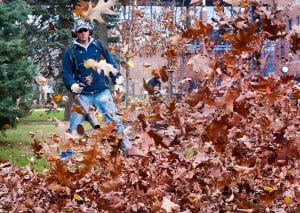The time of the falling leaves has come again. Once more in our morning walk we tread upon carpets of gold and crimson, of brown and bronze, woven by the winds or the rains out of these delicate textures while we slept. – John Burroughs, The Falling Leaves, Under the Maples

Ah, autumn. Leaf peeping drives, apple picking, pumpkin-spice everything, and the annual argument of what to do with those leaves falling on your yard.
On one hand, leaves can provide a natural mulch for the landscape, breaking down to provide organic matter and nutrients to soil, and provide habitat for native beneficial insects and arachnids. On the other hand, too many leaves can smother lawns and provide habitat for damaging diseases. But we’re not going to delve into that debate today. Today we’re focusing on the tick-leaf connection.

A recent study, Artificial Accumulation of Leaf Litter in Forest Edges on Residential Properties via Leaf Blowing Is Associated with Increased Numbers of Host-Seeking Ixodes scapularis (Acari: Ixodidae) Nymphs published in the Journal of Medical Entomology showed that when leaves where raked or blown along forest margins, blacklegged tick nymph populations tripled compared to areas where leaves were not artificially accumulated. (There was no observed impact on lone star ticks.)
Unintended consequences
While wind can accumulate leaves along a woodland edge, where leaves were intentionally blown off turfgrass and into the edge had significantly deeper leaf litter after two years. This deeper litter seems to create better conditions for tick questing, winter survival, or both. And those conditions create a greater risk of a tick encounter.
Because of the increase of blacklegged ticks, the papers authors, recommend that homeowners take advantage “of curbside leaf pickup services offered by many municipalities or request that lawn/landscaping contractors remove collected leaves offsite or at least to areas of less frequent use, rather than distributing them along the lawn-forest edge.”
This study did not look at the impact of mulching or composting leaves on tick populations, two techniques often recommended, but not studied under research conditions. We hope that future studies will take a closer look comparing different leaf management strategies and will better define how to avoid creating better tick habitat (better for them, worse for us).

Personal protection is still the best
In the meantime, however you are managing your leaves, remember to protect yourself from tick bites. Permethrin treated clothing, long pants tucked into socks and long sleeves tucked into garden gloves, and repellents will help to prevent you from becoming a tick’s next blood meal. Check out our Tick Prevention Tips video series on YouTube or Facebook. Found an embedded tick? Check out this blog post, Help! I found a tick on me!.
You can also visit our website, Don’t Get Ticked NY, for more information on ticks of NY, the risks they pose, and how to protect yourself.
